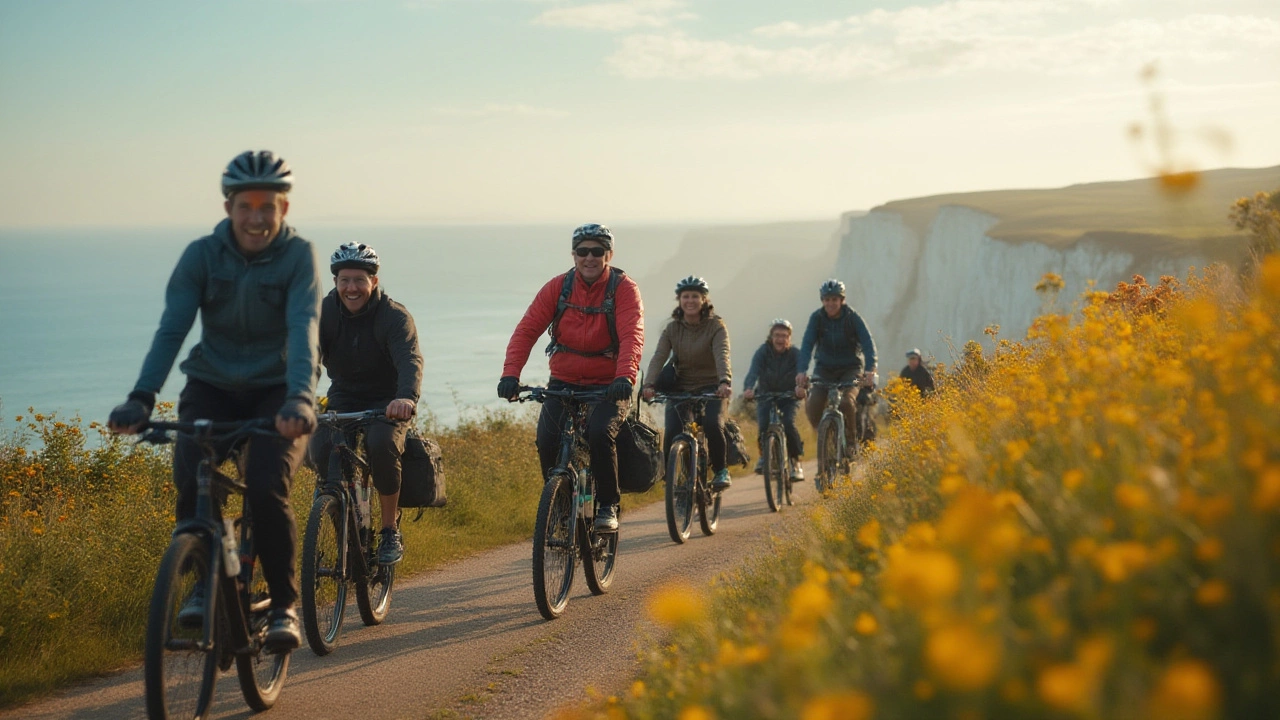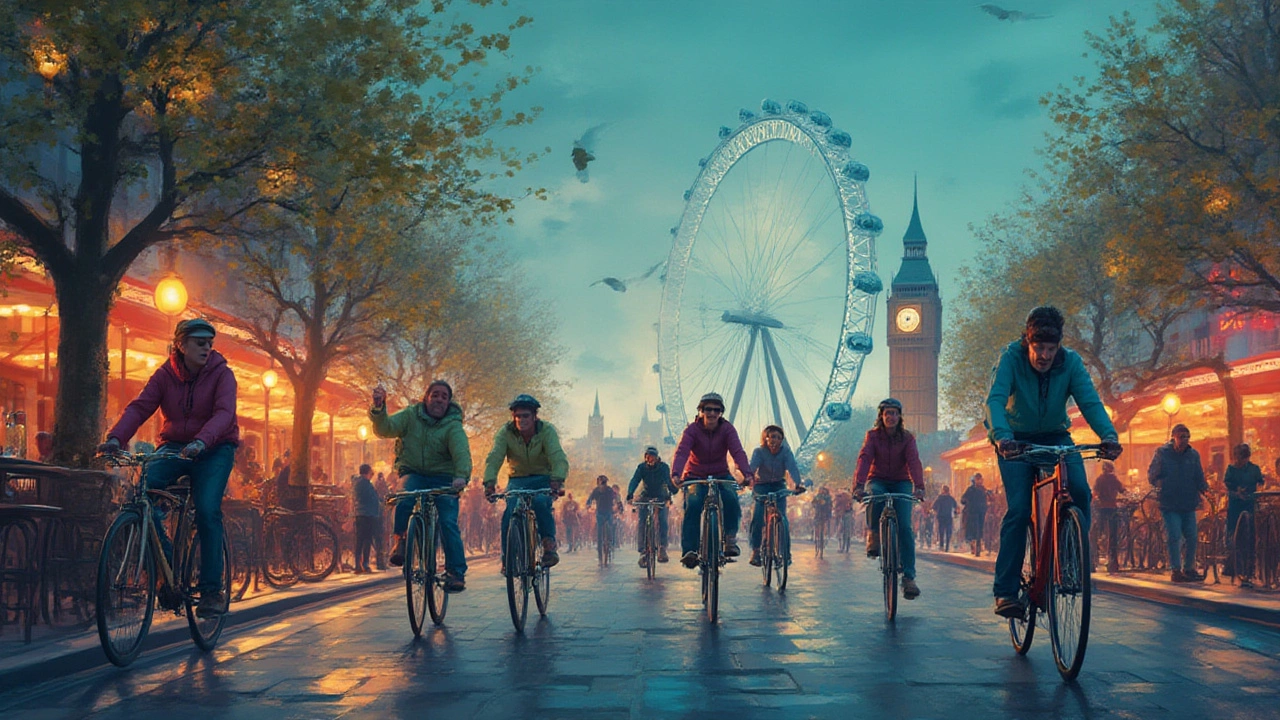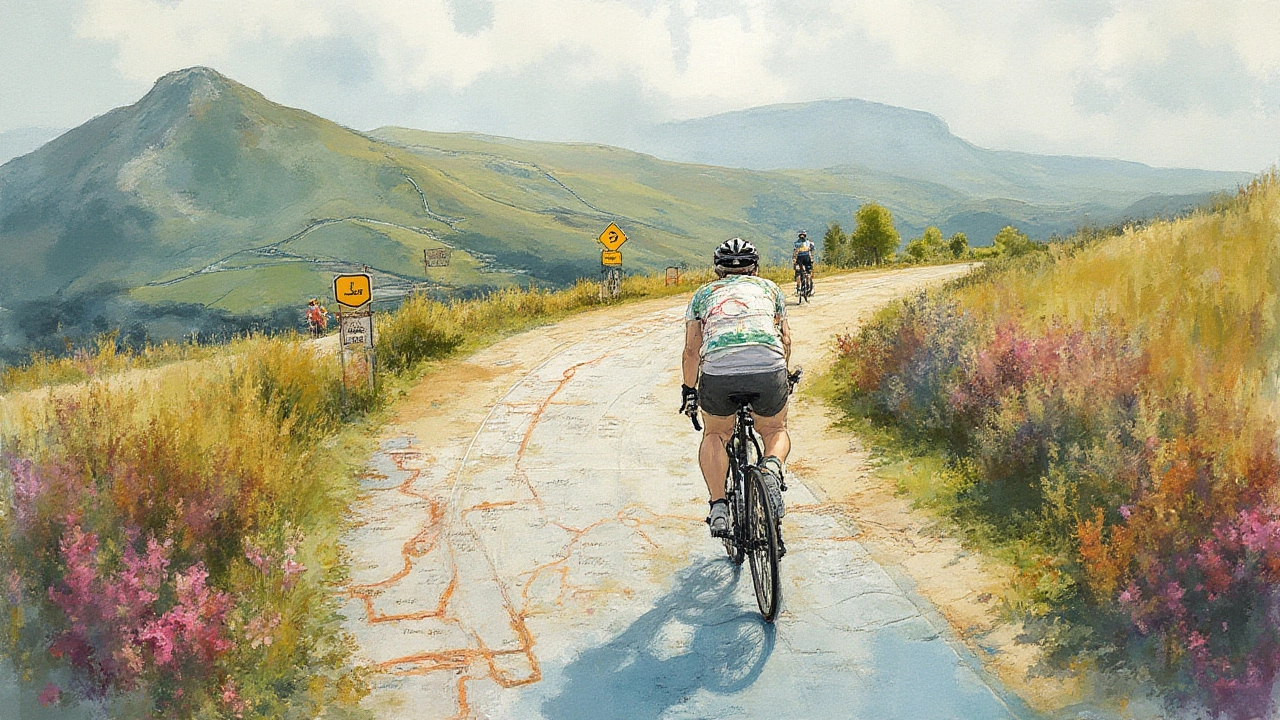Best Cycling Routes: Top Scenic and Challenging Paths for Every Rider

If someone told you that a bicycle can be your ticket to adventure, to untold beauty, maybe even to a sort of meditative peace you didn’t know you needed, would you really doubt it? Some of the best stories start not with an engine or a plane ticket, but with a couple of wheels, a beautiful route, and the thrill of what comes next. Whether you chase that sunrise after a sleepless night, map out a multi-country odyssey, or just squeeze in a city loop before Sunday brunch, cycling routes are about possibilities. But which ones deliver not just a solid workout, but memories worth repeating? Let’s find out where you should really be pedaling.
Scenic Wonders: The Most Beautiful Cycling Routes Worldwide
Think cycling is just smooth asphalt and predictable park paths? Think again. Some cycling routes read like bucket list entries for a reason. The Danube Cycle Path, for example—known locally as Donauradweg—spans over 1,700 miles from the Black Forest in Germany to the Black Sea. It’s flat, so accessible even for the not-so-seasoned, yet offers everything from medieval towns to riverside vineyards. No wonder more than 40,000 cyclists roll down its trails every year (according to Austrian tourism boards), making it Europe’s most popular bike path.
Hop over to the United States and you’ll find the Great Allegheny Passage (GAP) linking Pittsburgh to Cumberland, Maryland. Stretching 150 miles along abandoned rail corridor, the scenery morphs from forest to historic stone bridges, remote tunnels, and river gorges. Locals often tip visitors to try it during the fall when the leaves seem to turn into fireworks. And for those who crave wind-in-your-hair rides with an ocean view, the Pacific Coast Route reigns supreme. From Seattle to San Diego, the route runs close to 1,900 miles, hugging cliffs and skirting iconic beaches. Cyclists regularly spot seals in Monterey and eagles circling Big Sur from open viewpoints.
If urban rides are more your speed, Amsterdam’s network is built for two wheels. Nearly 500 kilometers of well-maintained cycle tracks, and more bikes than people in the city, mean you’re never fighting for road space. Locals say the best loop follows the Amstel River out to Ouderkerk, about 15km roundtrip, where you can punctuate your morning with poffertjes (mini pancakes) at a riverside café.
For daring souls, the Carretera Austral in Chile is another legend. Twisting through remote Patagonia, it spans 770 miles of gravel, ferry crossings, waterfalls, and jagged peaks. Only a few thousand cyclists attempt it each year, but every single ride turns into a saga—locals sell homemade empanadas from their front steps, condors soar overhead, and the weather can turn a bluebird day into a wild, rain-soaked test of will.
Meanwhile, New Zealand’s Otago Central Rail Trail is perfect for beginners and families. Opened in 2000, this 94-mile path passes through old gold mining towns, flower-painted valleys, and viaducts older than cars. The country maintains almost 10,000 kilometers of cycling trails now, with Otago staying at the top for almost every local looking for a weekend trip.
Sometimes, the best route is simply the one that shows you something new. Whether you care about wild landscapes or charming small towns, some of the world’s most breathtaking paths are also built to be accessible. Don’t worry about speed; bring a camera.
Challenging Rides: Tough Climbs and Advanced Cycling Routes
Looking for something that’ll push your quads to their limits? Let’s get into the legendary climbs and technical paths that even seasoned cyclists dream about. First stop: France’s Alpe d’Huez is notorious in the Tour de France, thanks to its 21 hairpin bends and over 3,700 feet of elevation gain packed into just 8.6 miles. The fastest Tour riders have raced up in under 40 minutes, while mortals might need two hours and a lot of grit. Locals like to joke that you haven’t really ‘done’ Alpe d’Huez until you’ve cursed it halfway up.
Across the Alps, Italy’s Stelvio Pass isn’t just a climb—it’s a rite of passage. Laid with 48 switchbacks on one side, reaching a dizzying 9,045 feet, Stelvio’s upper reaches can be icy even in July. Riders on travel blogs say it’s as much a mental challenge as a physical one—drivers cheer you on, but a moment’s distraction and you’ll wind up in a snowbank or faking a mechanical issue for a breather.
North America’s Mount Lemmon near Tucson, Arizona, is equally epic. This climb serves up 6,600 feet of elevation in just 21 miles, cutting through five climate zones—from cactus-dotted desert to pine forests and, wait for it, snow-capped peaks. Local bike shops report thousands of attempts each year, with most riders taking short breaks at the Cookie Cabin in Summerhaven—the only place with fresh-baked cookies waiting at the top.
For something a little different, the Taiwan KOM Challenge is the stuff of legends. It starts at sea level and ends at nearly 10,800 feet in Wuling Pass. The last 10 kilometers, with gradients hitting 17%, are famous for breaking even professional riders. 2023’s event had just 550 starters and less than 400 finishers. Anyone who crosses the finish line gets instant respect in the cycling world.
In Australia, the Great Ocean Road isn’t just scenic—it’s wind-swept and unpredictable. The Shipwreck Coast section can go from sunny to icy gusts in a single hour, keeping even experienced cyclists on their toes. Locals always remind visitors: bring a windproof jacket, and maybe a second set of brake pads.
If your heart’s set on gravel grinding, the Dirty Kanza in Kansas (now known as Unbound Gravel) features 200 miles of tire-shredding, sunbaked terrain. Riders carry their own supplies, patch countless flats, and often face triple-digit heat. Finish rates rarely cross 70%, and those who finish talk about it like it’s a wild badge of honor.
Whatever your poison—altitude, distance, or rough riding—every challenging route is a test. Pacing, preparation, and mindset matter as much as fitness. For every epic climb, there’s a story of a lost water bottle, a surprise lightning storm, or a perfect descent that makes all the grinding worth it.

Urban Riding: Top City Loops and Commuter-Friendly Routes
You don’t have to leave city limits to find memorable cycling routes. Urban riding is taking off, with cities from Copenhagen to Portland, Oregon, doubling down on bike-friendly infrastructure. In Copenhagen, 49% of locals bike to work every day. The city’s "Green Wave" system synchronizes traffic lights so bikers get a smooth ride into town—try the 13km Harbour Circle for waterfront views and café stops.
London’s Cycle Superhighways are a revelation if you want to dodge the Tube and skip the traffic. The CS3 runs from Barking to Tower Gateway, passing historic sites like the Tower of London. Usually, you’ll spot everything from fixies to cargo bikes loaded with groceries. During the morning crush, more than 700 cyclists might cross Blackfriars Bridge each hour, according to Transport for London data.
San Francisco’s Wiggle is a lifesaver, slashing the city’s notorious hills. Connecting Market Street to Golden Gate Park, the route uses gentle slopes and bike lanes to deliver a surprisingly flat cruise through the Haight and Lower Pacific Heights. You’ll see local messengers and weekend riders on everything from vintage bikes to electric cargo rigs.
Toronto’s Martin Goodman Trail is 56 kilometers of lakeside bliss. It connects downtown with beaches, parks, and the Toronto Islands, showing off the city’s softer side. The best time to ride is just after dawn, before the joggers and stroller mobs hit the boardwalk.
Paris has exploded in cycling popularity since 2020. The French capital now boasts over 1,000 kilometers of bike lanes, and the Seine-side cycling paths feel especially magical at sunrise or after midnight when the city glows. Foodies rave about the rides heading to open-air markets in Belleville—where you can pick up a fresh baguette as a mid-ride reward.
Japanese cities like Kyoto mix cycling ease with cultural immersion. The Philosopher’s Path is a leafy 2km stroll by foot or slow pedal, best enjoyed when cherry trees bloom in spring. For longer spins, locals recommend the Kamo River trail, which runs nearly 15 kilometers through the city and serves up temple views and riverside picnics.
What ties these city routes together? They make cycling reliable and welcoming. You’ll find clear signage, dedicated lanes, and a culture that respects two-wheeled commuters. Even if you only have an hour, a good city loop can make you feel like you’ve traveled much further.
Planning Your Ride: Preparation and Safety on Cycling Routes
So, how do you get the most out of any cycling route—whether it’s a casual city cruise or a cross-continental slog? It starts with planning. First, research trail conditions and elevation profiles. Most major routes, like the EuroVelo paths or the U.S. Adventure Cycling Association’s network, offer detailed maps and real-time weather updates online. Before hitting remote or mountainous routes, check for road closures, seasonal hazards (like avalanche or wildfire warnings), and whether you’ll have access to water or repair shops.
Prep your gear based on the ride. For paved paths, a road bike typically works best, but gravel or hybrid bikes are gaining popularity for their versatility. Helmets aren’t always legally required in every country, but it’s smart to always wear one. For longer routes, pack a multitool, patch kit, spare tube, portable pump, plenty of snacks (bananas and energy bars are classics), and at least one extra layer in case of weather changes.
Hydration can make or break a ride. On summer routes in Spain, the US Southwest, or Australia, experts recommend at least 500ml per hour of activity, more if you’re climbing. Electrolyte tablets or salty snacks can help prevent cramps on extra hot days. If you’re heading out in a new country, learn a few key phrases—like “water” or “help”—or download a translation app.
Safety isn’t just about helmets and high-vis. On busy or shared trails, ring your bell before overtaking, stick to the right (or left, depending on the local custom), and watch for unpredictable joggers, dogs, or city traffic. In mountainous or forested terrain, alert someone to your route, carry a phone with extra battery, and know the basics of first aid for minor crashes.
Weather is always the wildcard. Rain, wind, or snow can change road grip and visibility within minutes. Make sure your tires have enough tread, and avoid metal grates or painted road stripes after it rains—they get slippery. In winter, consider studded tires for ice. Locals often check out cycling forums for up-to-date tips, since nothing replaces the wisdom of someone who rode the route last weekend.
Cycling insurance is also gaining traction, covering everything from accidental damage to theft or healthcare abroad. For big trips, it’s a small price for peace of mind.
Below is a quick chart with data on some of the world’s most popular cycling routes:
| Route Name | Length (miles) | Country | Average Riders/Year | Elevation Gain (ft) |
|---|---|---|---|---|
| Danube Cycle Path | 1,770 | Germany/Austria/etc. | 40,000+ | Varies (mostly flat) |
| Great Allegheny Passage | 150 | USA | 500,000+ | ~1,700 |
| Stelvio Pass | 15 | Italy | 5,000+ | 6,000+ |
| Carretera Austral | 770 | Chile | <5,000 | Varies (up to 25,000) |
| Otago Central Rail Trail | 94 | New Zealand | 15,000+ | Minimal |

Insider Tips, Local Advice, and Hidden Gems
Some of the best rides aren’t always the ones with official signage or that show up on the front page of a travel site. Locals around the world know secret gems—routes that hug leafy rivers, cut through vineyards, or meander past ancient ruins nobody else seems to visit. In Tuscany, Italy, skip the main roads and look for the white gravel "strade bianche" where pro races roll. These scenic country roads wind past stone farmhouses and olive groves, and you’ll usually be alone except for the occasional sheep. Bring a puncture kit though—thorny wildflowers love bike tires as much as you do.
In Japan’s Shimanami Kaido, you’ll pedal across six islands connected by graceful bridges, sampling local seafood in tiny port towns. The route is only 43 miles, but riders talk about it all year for its mix of ocean vistas and peaceful gardens. Temples tucked off the marked trail almost always have a cold drink or snack, and locals are quick with directions if you get lost.
Sometimes, local bike clubs organize spontaneous group rides or themed events. In San Francisco, the "Sunday Streets" event shuts down major roads for car-free cruising once a month. Big city bike shops often know about pop-up coffee rides or themed night loops—ask around! You might find yourself pedaling past murals or food trucks you never noticed.
For more solitude, seek out trails at national parks just before or after the main tourist season. For example, Banff’s Legacy Trail in Canada is packed in July, but go late September, and you’ll cruise between golden poplars with only elk and a few locals for company. Early mornings mean fewer crowds almost everywhere, plus the light is better for photos—pros swear by this trick.
On hot days, find routes with shaded sections—forest loops or canal paths often stay cooler. Or ride at dusk; temperatures drop, and you’ll see more wildlife. Remember to check local rules about night riding and bring lights. For the adventurous, look up "bikepacking"—self-supported overnight rides combining cycling with camping turns even a local trail into a mini adventure.
One simple tip: always eat before you’re hungry and drink before you’re thirsty. Even short rides can take a surprise turn if you underestimate the route or the weather changes.
Whatever your level, be open to changing your plan if locals suggest something off your radar. Some of the most epic memories—a sunrise above the clouds, a roadside bakery that blows your mind—often happen when you’re not looking for them. The right cycling route isn’t just a line on a map, it’s the reason you remember why you ride in the first place.
So, what’s the best cycling route? It’s the one that leaves you grinning with satisfaction, airing out your legs, and already plotting your next spin. If your legs are tired and your heart is full, you picked the right road.
